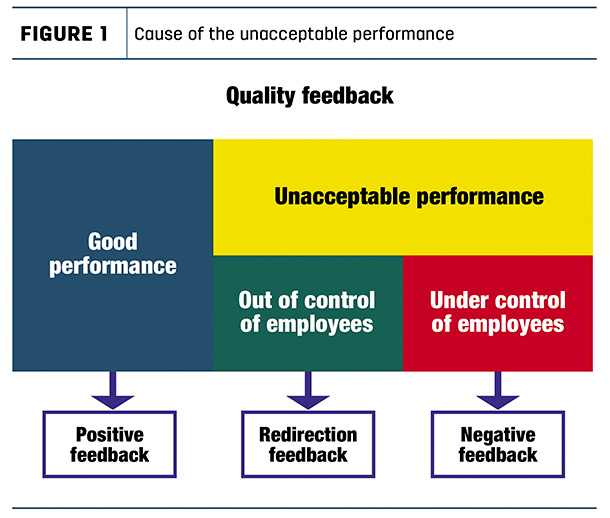Last month, we embarked on a series of articles around the theme “If you want good employees, be a good employer.” I suggested that a great way to address the current employment challenge is to implement a performance improvement system. (If you did not read the article, I suggest you click on the link above and read it.) The first step in providing quality feedback is to identify whether the employee has met or exceeded the expected performance or behavior, or failed to meet the expectation. Too often, the employee – and in some cases even the supervisor – cannot answer this question because there was no established expectation. This needed clarity is the basis of high-quality feedback and is why last month’s article outlined the possibilities of a performance improvement system.
Satisfactory performance
Positive feedback
We start with the first alternative: positive feedback. When I teach and consult on positive feedback, I make three points:
1. Most of you are working managers; you have both task and people responsibilities. You are well trained in the task responsibilities – cows, crops, etc. Your training was likely focused on identifying problems and solving them. There is no need for positive feedback in performing those tasks. Establishing a priority to identify specific opportunities to provide positive feedback is a huge and unfamiliar challenge. However, it is a challenge you must overcome to be a great supervisor – the people part of your responsibilities.
2. Although employees often fail to show a positive response to positive feedback, research and experience are clear that nearly everyone does respond positively. Several times, I have had managers share that they did not realize how great was the response to their increased positive feedback until they heard from the employees’ spouses.
3. During presentations, I often get the question: “Can one give too much positive feedback?” My answer is always: yes and no. Yes, one can give too much poor-quality positive feedback like “You’re doing great.” However, I do not believe one can give too much high-quality, specific positive feedback.
Unacceptable performance
Root causes, redirection feedback, negative feedback
The usual response to unacceptable performance is to provide negative feedback, typically perceived as a reprimand. As illustrated in Figure 1, that thinking is incomplete because the cause of the unacceptable performance may or may not be under the control of the employee.

Before providing feedback, a determination must be made regarding whether the failure to meet the expectation was or was not under the control of the employee. This decision requires the same type of analysis you use with livestock, crops, finances, etc., where you determine the root cause of the problem – the failure to grow/produce as expected.
This determination is more difficult with people issues than with animals and crops because we humans – you and the individual involved – have emotions. Often, the emotions are heightened by history of the issue or with the individual or the situation at hand. Just as with animal and crop issues, what we observe is most often a symptom. Determining the root cause is required to make an accurate decision on the type of feedback to provide.
The next step, likely the most important step, is determining whether redirection or negative feedback is appropriate. This step, of course, is not in our animal and crop problem-solving process. The decision as to the correct feedback is determined by the root cause. The two feedbacks are:
-
Redirection: Use when the root cause shows that the failure to perform was caused by the situation or the context of the performance – lack of training, ineffective supervision, unpredictable circumstances, unreasonable expectations. The supervisor must provide what is needed to enable the employee to meet the expectation.
- Negative: Use when the root cause shows that the situation cannot explain the failure; the failure to perform can only be explained by the employee’s personal characteristics – motivation, effort, commitment. The employee must change.
Because employees rarely intentionally make mistakes, redirection is the likely outcome of our root cause analysis. We should think of redirection feedback like learning from game film in sports. Redirection feedback allows employees to learn from their mistakes without the damage to the relationship and to their self-confidence that occurs with negative feedback.
In what parts of our society is providing redirection feedback routine? The answer is: sports and the arts. Continuous redirection feedback is an accepted part of seeking to win in sports and producing an outstanding performance in music, theater, etc. To work toward redirection feedback becoming an integral part of your farm success, meet often or regularly (performance improvement system) with your employees. Those meetings should have some structure, but you must work toward the meetings being positive and collegial with two-way discussion. Remember the competency motivating factor that employees want to improve and learn. I often call these meetings informal formal meetings.
The selection of negative feedback means that the employee must change. This will necessitate a bit more structure and composure by the supervisor. Successful negative feedback involves providing a choice to meet the expectation or incur some consequence. It is a choice – another motivating factor – not a reprimand.
As you seek to become a great employer, I suggest you establish a goal of positive and redirection feedback becoming an integral part of your culture. A result will be that negative feedback is rarely needed.







